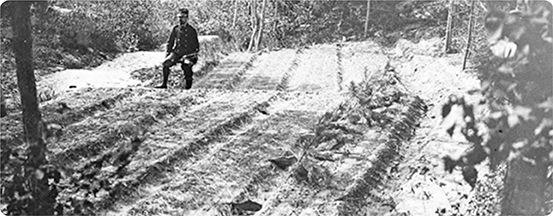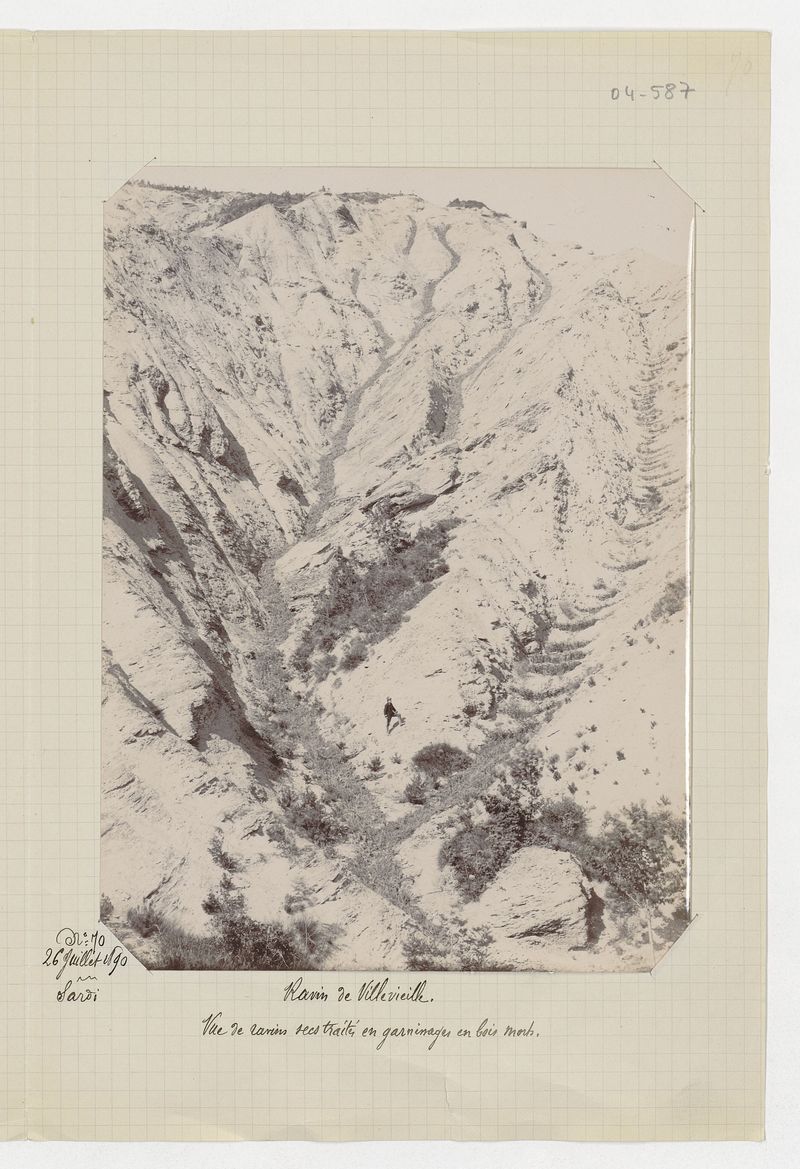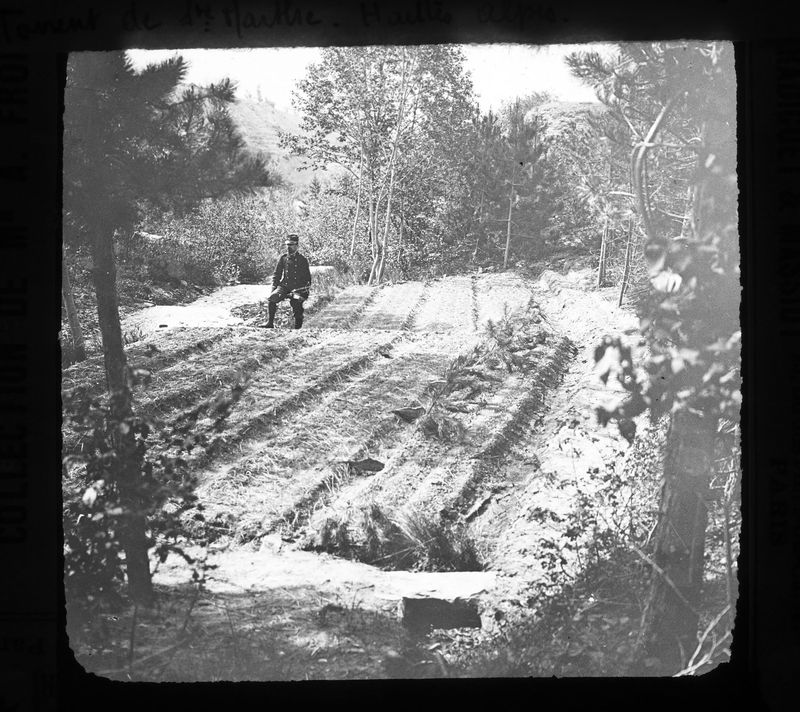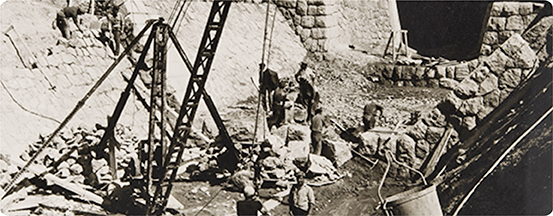Live brush check dams, grass seeding and reforestation, indirect protection
Since the 1860s, government departments have been working to secure natural and human habitats threatened by erosion and mountain torrents. Civil engineering and environemental engineering techniques are used to stabilise banks and reduce the slope of torrents.

Live brush check dams
These are wattle and fascine works. They can be used to stabilise the bed of the torrent, to stabilise the banks, to limit scouring (i.e. digging) and to reduce the slope by forming small silting zones
Wattle generally consists of willow branches interwoven and braided on stakes driven deep into the bed to form small walls.

Wattle, Cl. Bernard pp. 626-627, document available winter 2024- 2025
Fascine works are made up of willow fascines (bundles) stacked one on top of the other and fixed by stakes or piles in the case of the larger ones. Fascines can be placed across gullies, but they are also commonly used along riverbanks to prevent watercourses from wandering.
Willow branches can bud, taking root and creating a living barrier in the bed or on the banks.
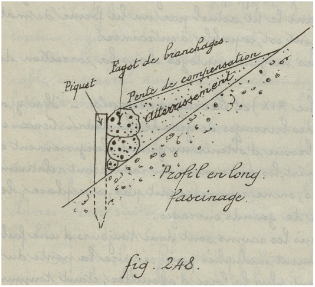
Fascine work, lesson from M. bernard 1927, document available in winter 2024-2025
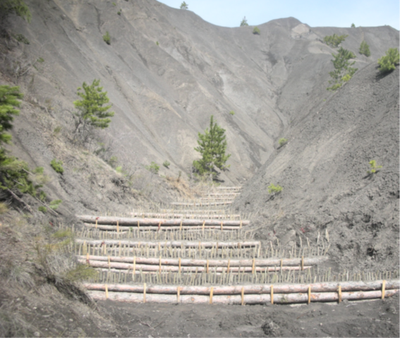 Freddy Rey 2008 (Inrae)
|
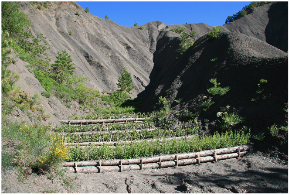
|
Filling (or bed shaping) involves positioning tree branches in the torrent bed, facing upstream to trap sediment. The base of the branches is held in place by stakes, wattle and crosspieces embedded in the ground. Once the branches are covered with material, another layer of branches can be added, gradually filling in the gully. This environment will then be more suitable for vegetation as it will be more stable, less steep and potentially more humid.
Grassing and reforestation
Grassing limits water run-off and retains soil on unstable ground. It can be a first step before planting trees. This grassing can be done by direct seeding, or by installing plugs.
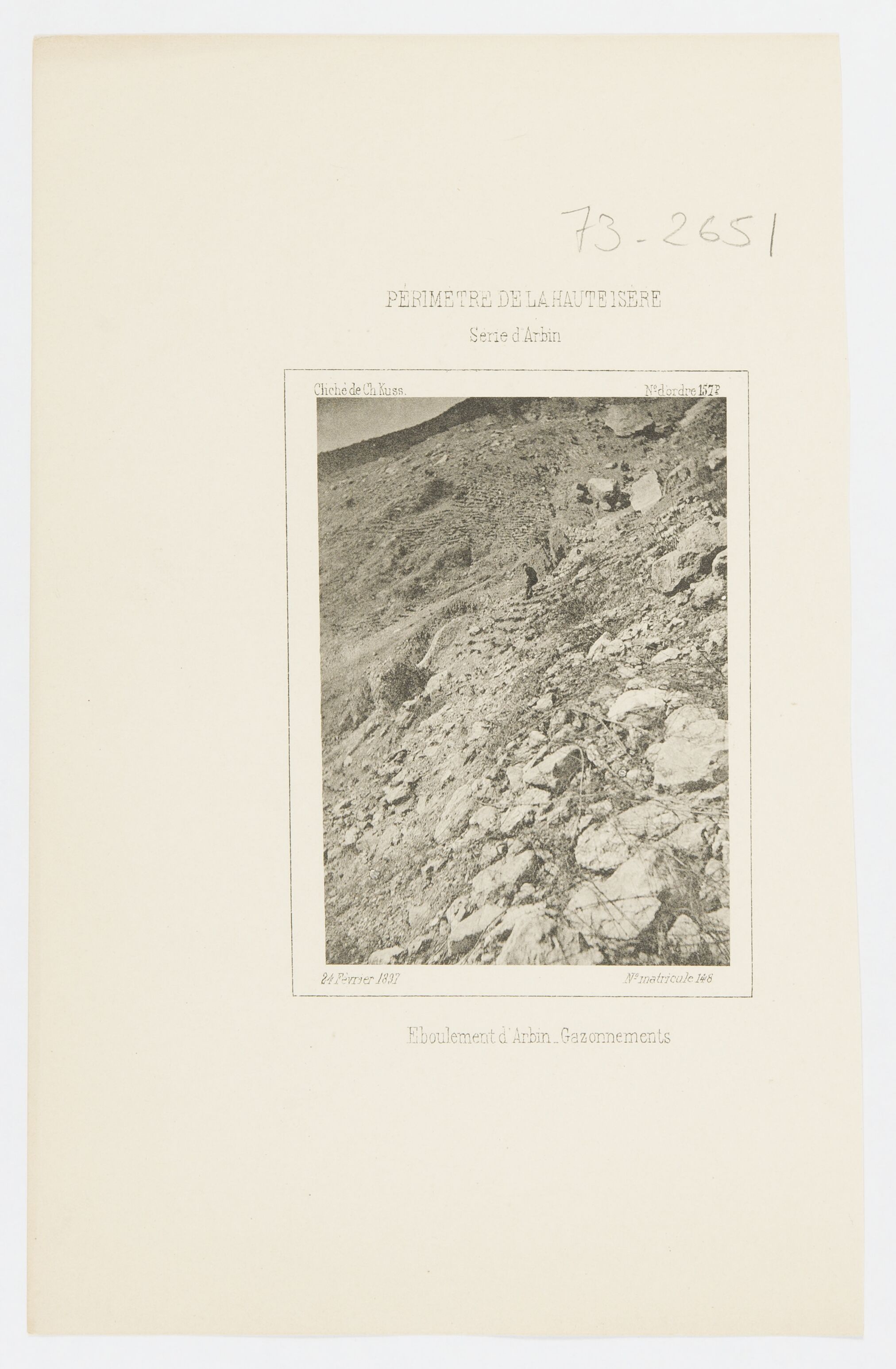
Arbin rockfall. Turfing. Kuss, 1897
Reforestation is the planting of trees on riverbanks, silting zones and lateral hillslopes, to retain sand and rocks, consolidate slopes, limit run-off and sometimes prevent snow movement. The forest cover protects the surfaces from the vagaries of the weather. It provides humus that will fertilise the soil, encourage the long-term establishment of vegetation and possibly slow the flow of rainwater or snow that melts on its surface. The reforestation services favoured the establishment of seedling forests, i.e. forests made up of large trees that regenerate by seeding.
And today at INRAE
At the LESSEM (Ecosystems and Societies in Mountains) laboratory in Grenoble, the COMPET and BIOSES teams are developing environmental engineering and soil bioengineering methods to reconcile protection against natural hazards with ecology. The results of their research and work contribute to the development of nature-based solutions.
Nature-based solutions are defined as “actions to protect, sustainably manage, and restore natural or modified ecosystems, that address societal challenges effectively and adaptively, simultaneously providing human well-being and biodiversity benefits.” (Source: IUCN, 2016).
Between 2002 and 2015, the "Soil bioengineering in the Durance river basin" project installed 2,000 structures consisting of wooden weirs topped with cuttings and nursery plants. These cordons and filings act as plant combs, retaining fine sediments while revegetating bare soil. They continue to develop.
Bibliography
Demontzey, P. (1882). Traité pratique du reboisement et du gazonnement des montagnes. (Practical treatise on mountain reforestation and turfing. In French). Rothschild J. (ed.), 528 p.
Demontzey, P. (1882). Le reboisement des montagnes. (Reforestation of the mountains. In French). La nature, n°496. p.151-155, p. 182-186, p.215-218, p.260-263.
Bénardeau, F., & Cuny, E. (1889). La science forestière illustrée. (Illustrated forestry science. In French). Ministère de l'agriculture service central, Fascicule 1, Partie 4.
Thiéry, E. (1891). Restauration des montagnes, correction des torrents, reboisement. (Mountain restoration, torrent correction, reforestation. In French). Baudry (Paris), 413 p.
Bernard, C. (1927). Cours de restauration des montagnes. (Mountain restoration course. In French). ENEF. 1st volume, text and plates. (Document available winter 2024-2025)
Bernard, C. (1927). Cours de restauration des montagnes. (Mountain restoration course. In French). ENEF. 2nd volume, planches. (Document available winter 2024-2025)
Clave, A. (1969). Rapport VI.3. Le rôle de la restauration des terrains en montagne dans la protection contre les inondations, in La prévision des crues et la protection contre les inondations. (The role of mountain land restoration in flood protection. In French). In: La prévision des crues et la protection contre les inondations (Flood forecasting and protection). Dixièmes journées de l’hydraulique. Paris, 5, 6 et 7 juin 1968. Tome 6, 1969.
Labonne, S., Rey, F., Girel, J., Evette, A. (2007). Historique des techniques de génie biologique appliquées aux cours d’eau. (History of biological engineering techniques applied to watercourses). Ingénieries eau-agriculture-territoires, 52, 37-48.
Bonin L, Evette A, Frossard P-A, Prunier P, Roman D, and Valé N. 2012. Génie végétal en rivière de montagne - connaissance et retour d’expériences sur l’utilisation d’espèces et de techniques végétales : végétalisation de berges et ouvrages bois (Soil bioengineering in mountain rivers - knowledge and feedback on the use of plant species and techniques: revegetation of riverbanks and wooden structures. In French). Europeen Union and Swiss Confederation. 321p. [online] Available from: http://www.genieecologique.fr/sites/default/files/documents/biblio/genialp_ouvrage_complet.pdf
Evette A et al. 2022. Le génie végétal sur les berges de cours d’eau : des techniques aux multiples bénéfices. Office français de la biodiversité (Soil bioengineering on riverbanks: techniques with multiple benefits. French Office for Biodiversity. In French) [online] Available from: https://professionnels.ofb.fr/fr/doc-comprendre-agir/genie-vegetal-berges-cours-deau-techniques-aux-multiples-benefices (Accessed 25 November 2022)
Leblois S, Evette A, Jaymond D, Piton G, Recking A. 2022. Processus et causes de défaillance du génie végétal pour la stabilisation des berges de rivière : retour d’expérience sur un large jeu de données issues de la BD GeniVeg (Why and how do soil bioengineering structures for river bank stabilization fail? Feedback on a large dataset from the GeniVeg database. In French). Géomorphologie : relief, processus, environnement 28 DOI: 10.4000/geomorphologie.16954
Didier M, Evette A, Schmitt E, Leblois S, Jaymond D, Evette J-B, Mira E, Raymond P, Frossard P-A, Vivier A. 2023. Les fascines de ligneux en génie végétal. Guide technique. Office français de la biodiversité – INRAE (The use of wooden fascines in soil bioengineering. A technical guide. French Biodiversity Office – INRAE. In French). https://www.researchgate.net/publication/371124569_Les_fascines_de_ligneux_en_genie_vegetal_Guide_technique
Text written by Pascale Hénaut (INRAE-DipSO).
Thanks to Guillaume Piton (Univ. Grenoble Alpes, INRAE, IGE) for his proofreading.
How to cite: Focus Agate: Live brush check dams, grass seeding and reforestation, indirect protection, Pascale Hénaut (INRAE-DipSO), november 2024. https://agate.inrae.fr/agate/en/content/highlights
Illustrations
The banner was made from a photography: "04-1313 : embroussaillement de ravins, torrent du Riou-Bourdoux, Journée, 1909"

The thumbnail was made from a photography: "pépinière de reboisement avec rigoles d'irrigation, torrent de Sainte Marthe"
